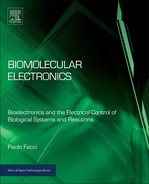Book Description
Biomolecular Electronics – the electrical control of biological phenomena – is a scientific challenge that, once fully realized, will find a wide range of applications from electronics and computing to medicine and therapeutic techniques. This new arena of biomolecular electronics is approached using familiar concepts from many areas such as electrochemistry, device electronics and some mechanisms of gene expression level control. Practical techniques are explored by which electrical and electronic means can be used to control biological reactions and processes. Also, the current and future applications for this new and expanding field are discussed. This book is aimed at scientists and engineers involved in both research and commercial applications across fields including bioelectronics, bionanotechnology, electrochemistry and nanomedicine – providing a state-of-the-art survey of what's going on at the boundary between biology and electronic technology at the micro- and nano- scales, along with a suggestive insight into future possible developments.
- Demystifies the science and applications of electrically-driven biological reactions.
- Explains how the techniques of bioelectronics and electrochemistry can be deployed as biological control technologies.
- Provides applications information for diverse areas from bio-electrochemistry to electrical control of gene expression levels.
Table of Contents
- Cover image
- Title page
- Table of Contents
- Copyright
- Dedication
- Quote
- Preface
- Chapter 1. Biomolecular Electronics
- Chapter 2. Useful Notions in Electrochemistry
- Chapter 3. Life and the Water-Based Environment
- 3.0. The peculiar chemical-physical properties of water
- 3.1. The hydrogen bond and the structure of water
- 3.2. The hydrophobic effect
- 3.3. The role of water in biology
- 3.4. Water and biomolecules
- 3.5. Biological reactions taking place in water
- 3.6. Biological reactions and phenomena involving the action of electric fields
- 3.7. Biological reactions and phenomena involving the transfer of electrons
- Chapter 4. Applications of Electrochemistry to Redox Metalloproteins and Cofactors
- 4.0. Redox metalloprotein and cofactor electrochemistry
- 4.1. Redox metalloproteins
- 4.2. Redox cofactors
- 4.3. Driving redox reactions of freely diffusing molecules
- 4.4. Driving redox reactions of surface immobilized molecules
- 4.5. Single biomolecule electron transfer
- 4.6. Electrochemically gated single-protein transistor
- Chapter 5. Electrochemistry can Drive Molecular Conformation
- 5.0. Direct electrochemical control of protein conformation at an electrode surface
- 5.1. Direct electrical modulation of the open/closed state of a voltage-gated potassium ion channel
- 5.2. Direct electrical control of antibody conformation and affinity
- 5.3. Towards direct electrical modulation of enzyme activity
- Chapter 6. Redox Control of Gene Expression Level
- Chapter 7. Towards Direct Electrochemical Control of Gene Expression Level
- Chapter 8. What will be Next?
- Index
